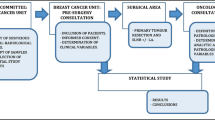Abstract
Background: The outcome of breast cancer is usuallydetermined by multiple factors. Serum tumor necrosis factoralpha concentration has been found to be increasedin the circulation of patients with malignancy. Thisstudy was designed with the aim to investigateany correlation between the serum tumor necrosis factoralpha and the clinicopathological fetures and furthermore evaluatethe prognostic significance of serum tumor necrosis factoralpha concentration in breast cancer. Methods: Forty consecutivepatients with invasive breast cancer undergoing modified radicalmastectomy were prospectively included and evaluated. Venous bloodsamples were collected before the surgery. Sera wereobtained by centrifugation, and stored at − 70°C until assayed. The control group consisted 30healthy, age-matched subjects. Serum concentrations of tumor necrosisfactor alpha were measured by the quantitative sandwichenzyme immunoassay technique. The data on tumor size,age, estrogen receptor status, lymph node status andTNM staging were reviewed and recorded.Results: The mean value of serum tumor necrosis factor alphain patients with invasive breast cancer was 1.47± 0.58 pg/ml and that of the controlgroup was 0.98 ± 0.37 pg/ml, and thedifference was significant (P < 0.01). With univariableanalysis, patients with maximum tumor size of 5cm or larger (P=0.03), more advancedTNM staging (P < 0.01); and more advancedlymph node status (P < 0.01) were shownto have significantly higher serum concentrations of tumornecrosis factor alpha. However, with multivariable analysis, TNMstaging appeared as the only independent factor (P< 0.01) predicting the significant, higher serum concentrationsof tumor necrosis factor alpha. Conclusion: Preoperative evaluationof serum tumor necrosis factor alpha concentrations maybe a valuable parameter for reflecting the severityof staging for invasive breast cancer.
Similar content being viewed by others
References
Balkwill FE, Burke F: The cytokine network. Immunol Today 10: 299–304, 1989
Beutler B, Cerami A: Cachectin: more than a tumor necrosis factor. N Engl J Med 316: 379–385, 1987
Beutler B, Cerami A: Cachectin and tumor necrosis factor as two sides of the same biological coin. Nature 320: 584–588, 1986
Sugarman BJ, Aggarwal BB, Hass PE et al.: Recombinant human tumor necrosis factor-alpha: effects on proliferation of normal and transformed cells in vitro. Science 230: 943–949, 1985
Nawroth PP, Stern DM: Modulation of endothelial hemostatic properties by tumor necrosis factor. J Exp Med 163: 740–745, 1986
Tracey KL, Lowry SF, Fahey TJ et al.: Shock and tissue injury induced by recombinant human cachectin. Science 234: 470–474, 1986
Girardin E, Grau GE, Dayer JM, Roux-Lombard P, the J5 study group, Kanbert PH: Tumor necrosis factor and interleukin-1 in the serum of children with severe infectious purpura. N Eng J Med 319: 397–400, 1988
Marano MA, Fong Y, Moldawer LL et al.: Serum cachectin/TNF in critically ill burn patients correlates with infection and mortality. Surg Gynecol Obstet 170: 32–38, 1990
Palek PQ, Lin Y, Collins JL: Natural cytotoxic cells and tumor necrosis factor activate similar lytic mechanisms. J Immunol 138: 1641–1644, 1987
Balkwill F, Osborne R, Burke F et al.: Evidence for tumor necrosis factor/cachectin production in cancer. Lancet ii: 1229–1232, 1987
Abrahamsson J, Carlsson B, Mellander L: Tumor necrosis factor-α in malignant disease. Am J Pediatr Hematol Oncol 15: 364–369, 1993
Ardizzoia A, Lissoni P, Brivio F, Tisi E et al.: Tumor necrosis factor in solid tumors: increased blood levels in the metastatic disease. J Biol Regul Homeost Agents 6: 103–107, 1992
Sheen-Chen SM, Chou FF, Eng HL, Chen WJ: An evaluation of the prognostic significance of HLA-DR expression in axillary-node-negative breast cancer. Surgery 116: 510–515, 1994
NIH Consensus Conference: treatment of early stage breast cancer. JAMA 265: 391–395, 1991
Staging for carcinoma of the breast. In: Beahrs O, Henson D, Hutter R, Myers M, (eds) Manual for staging of cancer, 3rd ed, Philadelphia: JB Lippincott, 1988, pp 145–150
Beutler B, Cerami A, Cachectin (Tumor Necrosis Factor): a macrophage hormone governing cellular metabolism and inflammatory response. Endocrine Reviews 9: 57–66, 1988
Coley WB: The treatment of malignant tumors by repeated inoculations of erysipelas; with a report of ten original cases. Am J Med Sci 105: 487–, 1893
O'Malley WE, Achinstein B, Shear MJ: Action of bacterial polysaccharide on tumors. II. Damage of sarcoma 37 by serum of mice treated with Serratia marcescens polysaccharide, and induced tolerance. J Natl Cancer Inst 29: 1169–, 1962
Beutler B, Greenwald D, Hulmes JD et al.: Identity of tumor necrosis factor and the macrophage-secreted factor cachectin. Nature 316: 552–554, 1985
Feinnan R, Hernriksen-DeStefano D, Tsujimoto M, Vilcek J: Tumor necrosis factor is an important mediator of tumor cell killing by human monocytes. J Immunol 138: 635–640, 1987
Abbate I, Correale M, Gargano G et al.: Tumor necrosis factor and soluble interleukin-2 receptor: two immunological biomarkers in female neoplasms. Eur J Gynaec Oncol XIII Supplement N. 1, 92–96, 1992
Knapp ML, Al-Sheibani S, Riches PG et al.: Hormonal factors associated with weight loss in patients with advanced breast cancer. Ann Clin Biochem 28: 480–486, 1991
McGuire WL, Clark GM: Prognostic factors and treatment decisions in axillary-node-negative breast cancer. N Engl J Med 326: 1756–1761, 1992
Author information
Authors and Affiliations
Rights and permissions
About this article
Cite this article
Sheen-Chen, SM., Chen, WJ., Eng, HL. et al. Serum concentration of tumor necrosis factor in patients with breast cancer. Breast Cancer Res Treat 43, 211–215 (1997). https://doi.org/10.1023/A:1005736712307
Issue Date:
DOI: https://doi.org/10.1023/A:1005736712307




